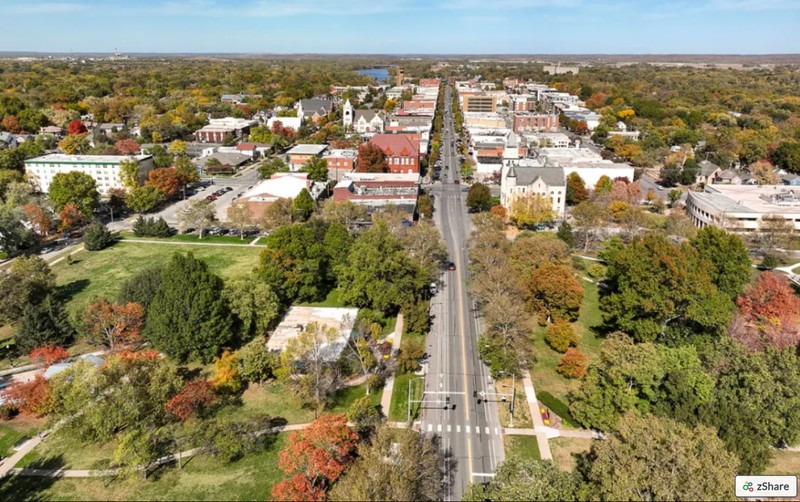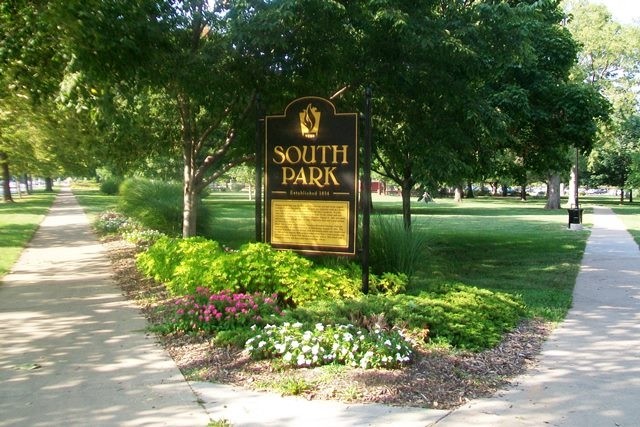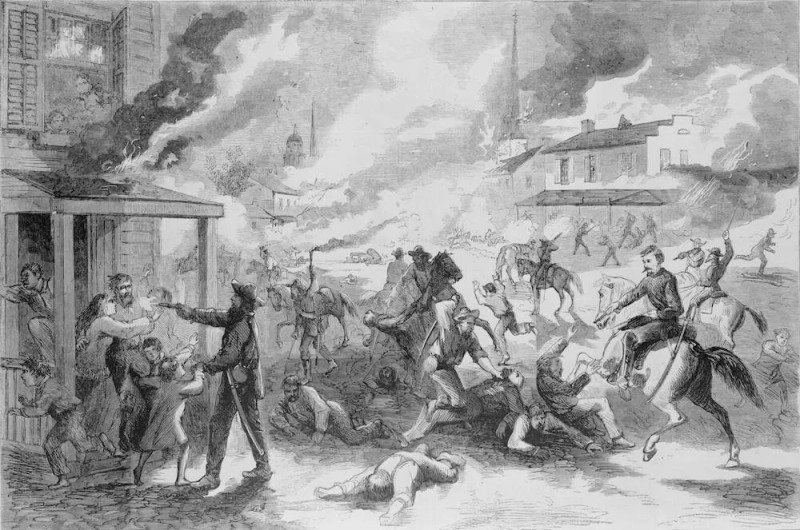South Park
Introduction
Text-to-speech Audio
South Park originally served as a public area for residents to grow crops and graze livestock. This green space later became a staging site for the infamous "Quantrill's Raid" on August 21, 1863. The raid became a defining point in Lawrence's history. At dawn on August 21, 1863, Quantrill and his raiders rode northwest through the outskirts of Lawrence and South Park toward their objective of the downtown business district. About four hours later, having completed their mission and wary of approaching Union troops, the raiders regathered just east of the park with their plunder and rode southward out of town.
Images
Aerial view of South Park, looking northward toward downtown Lawrence.

South Park and Historical Marker

A print from Harper’s showing Quantrill’s raid on Lawrence, Kansas, August 21, 1863

Backstory and Context
Text-to-speech Audio
Several members of the pro-abolitionist New England Emigrant Aid Company from Massachusetts established Lawrence during a tumultuous time in Kansas' history, shortly after the enactment of the 1854 Kansas-Nebraska Act, which specified that territorial residents would vote whether their state would be free or slave. The "Bleeding Kansas" era commenced, named for the bloody skirmishes between anti- and pro-slavery factions, which continued into the Civil War. Still, despite conflicts during the 1850s, the original Lawrence settlers developed an urban plan for Lawrence in 1855, which included a grid-pattern street design and South Park (Lawrence's first park).
The inspiration for the deadly attack on Lawrence ultimately stems from the hostility towards the Free State community by pro-slavery and Confederate sympathizers because the town played a primary role in keeping Kansas a free state (antislavery). Lawrence resident and Union brigadier general James H. Lane (who later served as a U.S. Senator) had previously led "Jayhawker" raids into Missouri, burning the town of Osceola in 1861. The 1863 Confederate guerrilla raid in Lawrence resulted in more than 150 male inhabitants dead, the city's business district set ablaze, and numerous residential homes destroyed (also by fire).
Lawrence not only rebuilt after the raid and Civil War but also enjoyed a ten-year growth consisting of a robust population increase, commercial expansion, and a building boom, which included rebuilding South Park. Today, one can find the historic Theodore Roosevelt Fountain in South Park, which the town dedicated after Roosevelt visited Lawrence in 1910.
Sources
Epps, Kristen. "Quantrill's Raid on Lawrence" Civil War on the Western Border: The Missouri-Kansas Conflict, 1854-1865. The Kansas City Public Library. Accessed February 13, 2024. https://civilwaronthewesternborder.org/encyclopedia/quantrills-raid-lawrence.
Fischer, William "South Park: Established 1854." The Historical Marker Database. hmdb.org. February 10, 2023. https://www.hmdb.org/m.asp?m=76603.
"South Park." City of Lawrence, Kansas. LawrenceKS.org. Accessed February 12, 2024. https://lawrenceks.org/lprd/parks/southpark/.
Wolfenbarger, Deon. "Registration Form: Lawrence's Downtown Historic District." National Register of Historic Places. nps.gov. 2004. https://www.kshs.org/resource/national_register/nominationsNRDB/Douglas_LawrenceDowntownHistoricDistrictNR.pdf.
Lawrence Times: https://lawrencekstimes.com/2023/12/31/big-changes-2024/
William Fischer, Jr., August 2, 2014. Historical Marker Database: https://www.hmdb.org/m.asp?m=76603
Image courtesy of Library of Congress via Smithsonian Magazine, https://www.smithsonianmag.com/history/wealthy-activist-who-helped-turn-bleeding-kansas-free-180964494/
